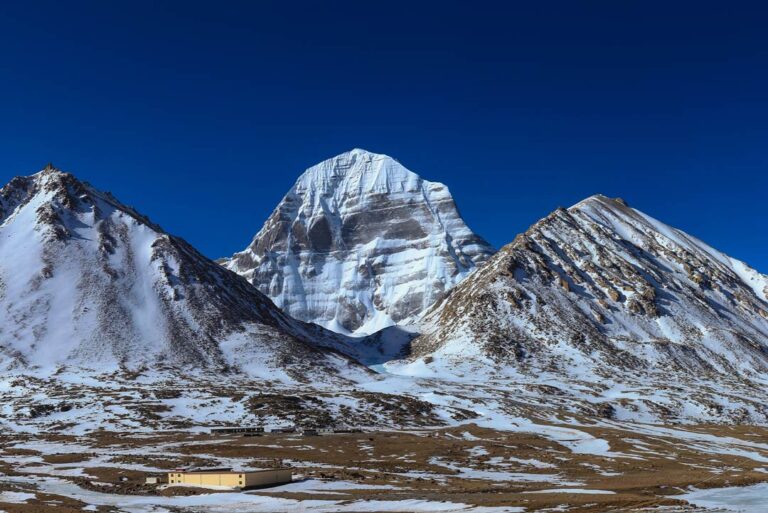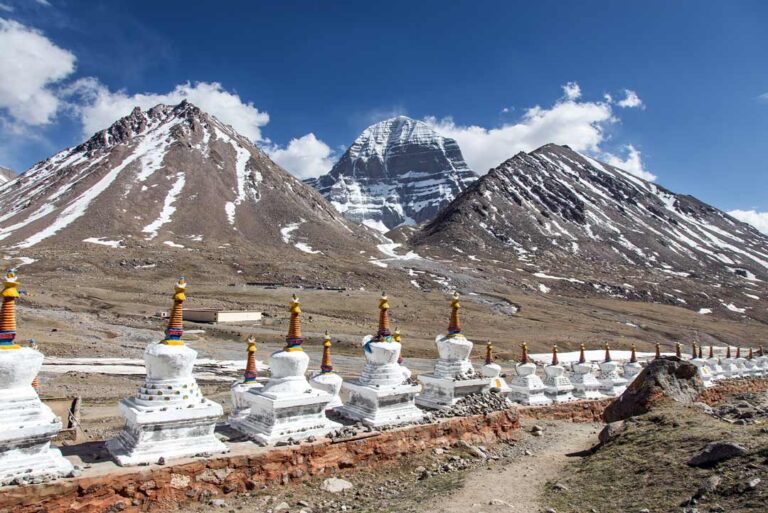Embarking on the sacred journey of Kailash Mansarovar Yatra opens the doors to mystical landscapes and revered pilgrimage sites. Among these, Ashtapad Tirtha stands as a jewel, offering profound spiritual experiences. Let’s delve into the heart of Ashtapad Tirtha, exploring its location, religious significance, breathtaking views, and the cultural richness it holds. Nestled in the Tibetan village of Darchen, Ashtapad unfolds its magnificence against the backdrop of the mighty Mount Kailash. Its elevation of 4900 meters adds a touch of awe to the spiritual seekers who make the pilgrimage. The religious significance of Ashtapad extends beyond its geographical location; it is revered by both Hindus and Jains alike. For Jains, it marks the hallowed ground where their first Tirthankara, Shri Rishabhadev Bhagwan, achieved Nirvana. Simultaneously, Hindus hold it dear as an abode of Lord Shiva, adding layers of spiritual depth to the pilgrimage.
The journey to Ashtapad Tirtha not only captivates the senses with its natural beauty but also invites pilgrims to embrace the adventure of reaching Darchen, the gateway to Kailash Parikrama. The steep and boulder-lined route, punctuated with stream crossings, adds a sense of exhilaration to the pilgrimage. As pilgrims approach Ashtapad, they are met with heart-stirring views of the southern face of Mount Kailash and the Meru Danda, creating a canvas of divinity. The cultural tapestry woven into the landscape is evident in the presence of the Nandi peak and the Hindu temple on Nandi Parvat, crafted by Chakravarti Smraat Bharat. Ashtapad’s historical and religious importance becomes more tangible, inviting pilgrims to not just witness the beauty but to be immersed in the rich spiritual heritage it holds.

Location and Accessibility of Ashtapad Tirtha
Ashtapad is nestled in the quaint village of Darchen, located in Purang County in the Tibet Autonomous Region of China. Serving as the gateway to the pilgrimage, Darchen is the starting point for seekers venturing towards the sacred Mount Kailash. This tiny village holds profound significance as it marks the initiation of the spiritual journey toward Ashtapad and Mount Kailash. Pilgrims, upon reaching Darchen, stand at the threshold of a sacred odyssey, where the air is charged with a sense of reverence and anticipation. The village, with its humble dwellings against the backdrop of majestic peaks, provides a serene setting for pilgrims to prepare their hearts and minds for the transformative experiences that lie ahead.
Access to Darchen is a journey in itself, as travelers navigate through the rugged terrains of Tibet. The road to Darchen is a testament to the commitment required for the Kailash Mansarovar Yatra. Pilgrims, braving the adventurous route, are rewarded not only with the destination’s spiritual sanctity but also with the picturesque beauty that unfolds along the way. The journey to Darchen is an essential part of the pilgrimage experience, offering pilgrims a chance to connect with the natural wonders surrounding Ashtapad and fostering a sense of unity with fellow seekers on the same sacred path.
Religious Significance of Ashtapad Tirtha
For Jains, Ashtapad Tirtha holds unparalleled importance as the site where the first Jain Tirthankara, Shri Rishabhadev Bhagwan, attained Nirvana. This spiritual milestone draws Jains from across the globe to pay homage to the revered spot where their founding figure achieved ultimate liberation. The sanctity of Ashtapad is further magnified as pilgrims ascend the mountain, each step echoing with the ancient echoes of devotion and enlightenment. Simultaneously, Ashtapad is not only a cherished destination for Jains but also a sacred ground for Hindus. Hindus believe that the mountain is an abode of Lord Shiva, adding another layer of religious significance to the site. The coexistence of these dual religious beliefs amplifies the spiritual aura of Ashtapad, making it a unique and harmonious destination where diverse communities come together in reverence.
This dual religious significance adds to the sanctity of Ashtapad, creating a tapestry of cultural and spiritual diversity that is woven into the very fabric of the pilgrimage experience. As pilgrims gather at Ashtapad, they share a common thread of seeking divine connection, each influenced by their respective traditions and beliefs. The mountain becomes a meeting point for spiritual seekers, fostering an atmosphere of unity and respect among the pilgrims. This interweaving of Jain and Hindu traditions at Ashtapad reflects the inclusive nature of the pilgrimage, where the sacredness of the site transcends religious boundaries and invites all to partake in the spiritual journey.
Topography and Views of Ashtapad Tirtha
Situated at an elevation of 4900 meters, Ashtapad offers breathtaking views of the southern face of Mount Kailash and the Meru Danda. The altitude accentuates the spiritual aura of Ashtapad, as pilgrims ascend to these heights, symbolically drawing closer to the divine. The panoramic vistas from Ashtapad Tirtha unfold like a divine painting, where every peak, valley, and the expanse of sky becomes a canvas painted with the colors of spirituality. Pilgrims and travelers alike find themselves captivated by the sheer grandeur of the landscape, creating a profound connection between the terrestrial and the celestial.
The southern face of Mount Kailash, visible from Ashtapad, is a sight to behold. The Meru Danda, resembling a celestial spine, runs through the middle, adding a mystical touch to the scenery. The play of light and shadow on the mountainous terrain creates a dynamic visual spectacle that evolves throughout the day. Ashtapad, positioned as an elevated vantage point, allows pilgrims to immerse themselves in the sacred beauty of Mount Kailash, fostering a sense of awe and reverence. The views from Ashtapad, beyond being a visual treat, serve as a reminder of the spiritual journey undertaken, where every step leads pilgrims closer to the divine essence embodied by the sacred Mount Kailash.
Nandi Peak and Hindu Temple
The presence of the Nandi peak, shaped like the sacred Nandi bull, adds a mystical touch to Ashtapad. As pilgrims gaze upon this natural marvel, they are reminded of the sacred symbolism associated with Nandi, the devoted mount of Lord Shiva in Hindu mythology. The spiritual significance deepens as Chakravarti Smraat Bharat’s creation of a Hindu temple on Nandi Parvat comes into focus. This artistic marvel, crafted with reverence, stands as a testament to the historical importance of Ashtapad. Chakravarti Smraat Bharat, an ancestor of the Pandavas and Kauravas, left a lasting legacy by establishing this temple, making Nandi Parvat not only a geological wonder but also a repository of cultural and religious heritage.
The Hindu temple on Nandi Parvat becomes a sacred haven for pilgrims, offering a place for reflection and worship amidst the breathtaking natural surroundings. The intricate details of the temple, carved into the rocky landscape, narrate tales of devotion and serve as a link to the rich historical tapestry of the region. As pilgrims ascend to Nandi Parvat, they not only witness the beauty of the natural world but also connect with the spiritual and historical threads that weave through the very fabric of Ashtapad. The Nandi Peak and its accompanying temple stand as enduring symbols of devotion, inviting pilgrims to partake in the collective spiritual journey etched into the heart of this sacred mountain.
Pilgrimage Importance
While Mount Kailash claims widespread fame, Ashtapad stands as an equally significant religious destination. Pilgrims, drawn by the beauty and devotion associated with this place, consider themselves fortunate to experience its spiritual charm. The journey to Ashtapad is not merely a physical pilgrimage; it is a profound spiritual odyssey that transcends the boundaries of the mundane. As pilgrims undertake the 52 km Parikrama of Mount Kailash, with Ashtapad as a crucial waypoint, they immerse themselves in the divine energy that permeates the surroundings. The scenic landscapes, the majestic peaks of Nandi Parvat and Mount Kailash, and the historical Hindu temple create an atmosphere of profound sanctity that resonates with the innermost spiritual yearnings of the pilgrims.
The pilgrimage to Ashtapad becomes a transformative experience, not just because of its geographical location but because of the spiritual significance attached to every step taken on this sacred land. Pilgrims often express a sense of awe and humility as they navigate the challenging terrain, understanding that the journey is not just about reaching a physical destination but attaining a higher state of consciousness. The spiritual magnetism of Ashtapad, intertwined with the rich tapestry of Hindu and Jain beliefs, elevates the pilgrimage beyond a physical endeavor, turning it into a soul-stirring exploration of faith, devotion, and the divine connection that binds all pilgrims on this sacred path.
Ashtapad Tirtha’s Historical Importance
The historical tapestry of Ashtapad is woven with threads of devotion and cultural significance, creating a narrative that transcends time. The mountain stands as a testament to the deep-rooted spiritual history embedded in its terrain. The Hindu temple, a creation attributed to the lineage of Chakravarti Smraat Bharat, resonates with historical richness, echoing the footsteps of ancestors who dedicated themselves to divine reverence. This temple, carved from the very rock of the mountain, symbolizes the enduring legacy of faith and architectural prowess. Each stone in the temple serves as a silent witness to the countless pilgrims and seekers who have traversed the sacred path, leaving behind imprints of devotion and cultural heritage.
The layers of historical importance continue to unfold as pilgrims explore the intricacies of the Hindu temple, revealing the meticulous craftsmanship and spiritual fervor that went into its creation. Chakravarti Smraat Bharat’s contribution becomes a bridge connecting past and present, inviting contemporary pilgrims to step into the sacred space and become part of a legacy that spans generations. Ashtapad’s historical significance extends beyond its natural beauty, offering a profound glimpse into the spiritual evolution of those who have revered this mountain, making it an integral chapter in the sacred narrative of the Kailash Mansarovar Yatra.
Climate and Weather Conditions
Understanding the climate of Ashtapad is crucial for a successful pilgrimage. Winters bring chilly temperatures, dropping to -15 degrees Celsius, while summers between May and August offer pleasant weather. Pilgrims must consider these conditions for a safe and comfortable journey.
In the winter months, Ashtapad transforms into a serene white landscape, presenting a stark contrast to the warmer seasons. The pristine snow-covered peaks and the tranquil surroundings create a breathtaking winter wonderland. Pilgrims venturing during this period must be well-prepared for the harsh cold, ensuring they have appropriate clothing and gear to withstand the sub-zero temperatures. On the other hand, the summer months provide a different allure, with the landscape bursting into vibrant colors. The pleasant weather makes it an ideal time for pilgrims to undertake the challenging 52 km Parikrama of Mount Kailash, a spiritual journey that demands physical endurance and devotion. The changing seasons at Ashtapad add a dynamic dimension to the pilgrimage experience, allowing seekers to witness the divine beauty in various forms throughout the year.
Adventure of the Journey to Darchen
The journey to Darchen unfolds as more than a physical passage—it is a transformative and adventurous exploration etched into the fabric of the Kailash Mansarovar Yatra. Navigating the route towards Darchen is a pilgrimage in itself, as it winds through landscapes that echo the divine resonance of the sacred Mount Kailash. The path, marked by its steep ascent and adorned with rugged boulders, provides a visual and sensory spectacle for pilgrims, creating an atmosphere charged with spiritual energy. Every twist and turn reveals panoramic views, serving as a prelude to the sanctity awaiting at the destination.
Amidst the rocky terrain, pilgrims are treated to a scenic and thrilling drive that amplifies the pilgrimage’s significance. The geological challenges of the journey not only add a layer of adventure but also symbolize the hurdles one must overcome in their spiritual quest. The act of crossing streams along the way becomes a metaphorical crossing of spiritual thresholds, each step resonating with the commitment and determination required for a profound pilgrimage experience. In the embrace of nature’s grandeur, pilgrims find themselves immersed in a journey that goes beyond the physical, embodying the essence of the sacred Kailash Mansarovar Yatra.
Accommodation and Eating Options
In Darchen, where the spiritual odyssey to Ashtapad begins, accommodation options primarily consist of basic guesthouses and camping grounds. Pilgrims seeking a more immersive experience often opt for camping, allowing them to be one with the serene surroundings. These humble accommodations, though simple, contribute to the authenticity of the pilgrimage, fostering a sense of unity among the fellow travelers.
Due to the remote location of Darchen and the limited availability of restaurants, pilgrims are advised to carry personal food supplies. This recommendation aligns with the pilgrimage’s essence, emphasizing self-sufficiency and preparedness. The dietary aspect adds a unique dimension to the journey, with the proximity to Mount Kailash and Lake Manasarovar influencing the culinary choices. As a mark of respect for the sacred surroundings, pilgrims willingly adhere to a vegetarian diet during their stay in Darchen, further enhancing the spiritual experience of the Kailash Mansarovar Yatra.
In this close-knit community of pilgrims, the shared meals, whether prepared individually or collectively, become a communal celebration of faith and endurance. The simplicity of these arrangements fosters a deeper connection with the spiritual essence of the pilgrimage, making each meal a sacred communion amidst the awe-inspiring landscapes.
Cultural Respect and Pilgrim Guidelines
Pilgrims approaching Ashtapad are not only embarking on a physical journey but also a cultural and spiritual odyssey. The sacredness of this site demands a profound sense of cultural respect and awareness from all who tread its paths. Simple behavior, characterized by humility and reverence, forms the cornerstone of a pilgrim’s conduct. As devotees traverse the landscapes, they are reminded to move with a quiet sense of introspection, acknowledging the sanctity of the surroundings. The sacred stones of Ashtapad, regarded as incarnations of gods, call for pilgrims to step with a gentleness that reflects their understanding of the divine presence that permeates every inch of this revered mountain.
In addition to demeanor, waste disposal practices play a pivotal role in maintaining the purity of the pilgrimage experience. Pilgrims are encouraged to carry a sense of responsibility towards the environment, ensuring that the sacred grounds remain untarnished. The act of disposing of waste in designated areas is not merely a practical necessity but a symbolic gesture of preserving the sanctity of Ashtapad. Furthermore, interactions with fellow pilgrims are infused with respect, creating a harmonious communal spirit. The shared devotion to Ashtapad unites individuals from diverse backgrounds, fostering an environment where cultural exchange and mutual understanding flourish, enriching the overall pilgrimage journey.
The Magnificence of Ashtapad Tirtha
Ashtapad Tirtha stands as a testament to nature’s grandeur, captivating pilgrims and travelers with its breathtaking beauty. The mountain’s peaks, Nandi Parvat and Mount Kailash, rise majestically against the backdrop of the Tibetan landscape. Nandi Parvat, resembling the sacred Nandi bull, adds a mystical touch, while Mount Kailash, with its sheer magnificence, is the focal point of devotion. The play of sunlight on the rugged terrain and the serene atmosphere at an altitude of 4900 meters create a surreal setting that transcends the physical realm.
Beyond its aesthetic appeal, Ashtapad exudes a spiritual charm that resonates with the devout. Pilgrims find solace in the serene surroundings, where every stone is regarded as an incarnation of the divine. The air is filled with a sense of reverence, and the journey to this sacred site becomes a transformative experience. Ashtapad’s historical significance, coupled with the religious narratives intertwined with its existence, amplifies the spiritual journey, leaving pilgrims humbled and in deep contemplation. In the heart of Ashtapad, the convergence of nature’s grandeur, spiritual aura, and cultural significance creates a pilgrimage destination that transcends the ordinary, inviting those who seek a connection with the divine to embark on a soul-stirring odyssey.
Conclusion of Ashtapad Tirtha
In concluding this journey through Ashtapad Tirtha, we recognize it as a spiritual gem, drawing pilgrims seeking divine connection. The confluence of Hindu and Jain symbolism, coupled with the breathtaking views, makes Ashtapad an integral part of the profound Kailash Mansarovar Yatra experience.
FAQs
Q: Is Ashtapad equally important for Hindus and Jains?
A: Absolutely, Ashtapad stands as a harmonious convergence of religious significance for both Hindus and Jains, solidifying its status as a revered pilgrimage destination. For Hindus, Ashtapad is considered an abode of Lord Shiva, and the presence of a Hindu temple on Nandi Parvat, established by Chakravarti Smraat Bharat, adds historical and cultural depth to the site. On the Jain front, Ashtapad holds exceptional importance as the sacred ground where the first Jain Tirthankara, Shri Rishabhadev Bhagwan, attained Nirvana. The coexistence of Hindu and Jain symbolism, along with the breathtaking views it offers, creates an atmosphere that resonates with spirituality, drawing pilgrims from both faiths to partake in the divine aura of Ashtapad.
Q: What is the best time to visit Ashtapad?
A: The summer months between May and August offer the most pleasant weather for the pilgrimage to Ashtapad. During this period, temperatures are relatively mild, creating optimal conditions for pilgrims to undertake the challenging yet spiritually rewarding journey. The warmer weather enhances the overall pilgrimage experience, allowing visitors to fully immerse themselves in the breathtaking views and cultural richness of Ashtapad. The snow-capped peaks and serene landscapes become more accessible, creating an atmosphere conducive to introspection and spiritual growth. Pilgrims are advised to plan their visit during these months to ensure a comfortable and safe exploration of this sacred destination on the Kailash Mansarovar Yatra. This timeframe also aligns with the region’s lesser rainfall, reducing the likelihood of weather-related challenges and ensuring a more seamless pilgrimage experience.
Q: Are there accommodation options in Darchen?
A: Indeed, Darchen caters to the accommodation needs of pilgrims with a selection of basic guesthouses and camping grounds. These options provide a humble yet comfortable retreat for those embarking on the sacred Kailash Mansarovar Yatra. Pilgrims can choose between the simplicity of guesthouses, which offer a glimpse into the local mountain life, or the immersive experience of camping, allowing them to be closer to the natural beauty that surrounds Darchen. The accommodations align with the serene and spiritual atmosphere of the region, ensuring a restful stay for those seeking solace and connection on their pilgrimage.
Q: How challenging is the journey to Darchen?
A: The journey to Darchen presents an exhilarating adventure for pilgrims, as the route unfolds with steep paths and thrilling stream crossings. Navigating through the rugged terrain adds an element of excitement to the pilgrimage, making the drive both scenic and awe-inspiring. Pilgrims should be prepared for the challenges posed by the steep inclines and boulder-lined roads, ensuring that the journey to the gateway of Mount Kailash becomes not just a physical passage but a memorable and adventurous part of the sacred Kailash Mansarovar Yatra experience.
Q: Why is Ashtapad considered a spiritual magnet for pilgrims?
A: Ashtapad’s allure as a spiritual magnet lies in its captivating beauty, cultural richness, and profound spiritual charm, making it an irresistible destination for pilgrims embarking on the transformative journey of the Kailash Mansarovar Yatra. The unparalleled views of the southern face of Mount Kailash, coupled with the divine symbolism of Nandi Parvat and the Hindu temple, create an ethereal atmosphere that resonates with the spiritual quest of seekers. The coexistence of Hindu and Jain religious elements adds a unique layer of cultural significance, fostering a sense of unity and reverence among pilgrims. Ashtapad’s historical importance, intertwined with the legacy of Chakravarti Smraat Bharat, further enhances its magnetism, leaving pilgrims in awe of the mountain’s majestic peaks and the spiritual serenity that permeates the sacred grounds.












